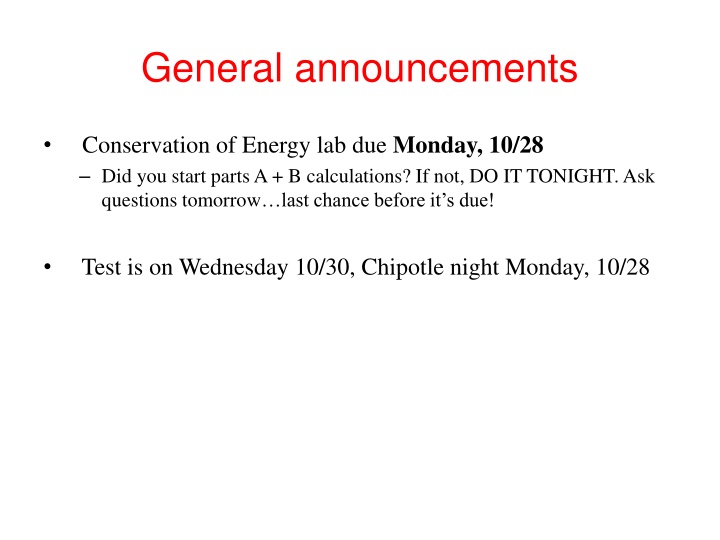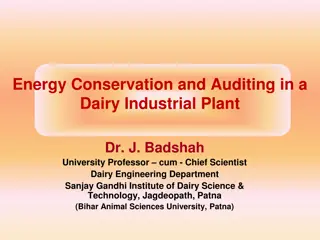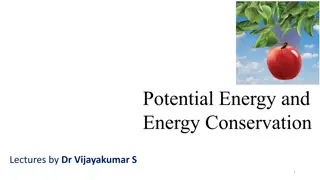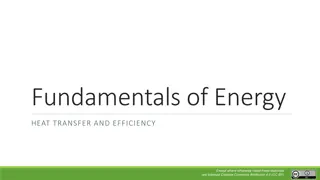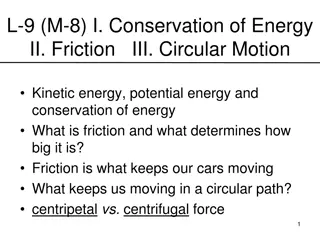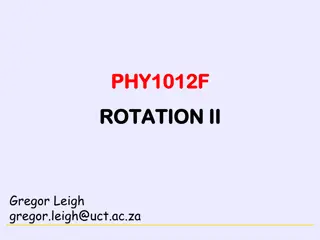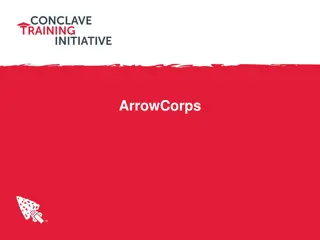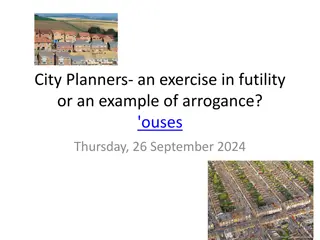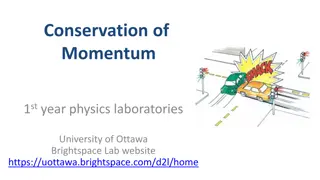Physics Lab Due Soon: Energy Conservation and Atwood Problem Revisited
Physics students are reminded about the Conservation of Energy lab due on Monday, with urgent reminders to complete calculations for parts A and B. Additional problems on Atwood's machine and a complex energy conservation scenario are presented, challenging students to apply their understanding of physics principles to solve various problems.
Download Presentation

Please find below an Image/Link to download the presentation.
The content on the website is provided AS IS for your information and personal use only. It may not be sold, licensed, or shared on other websites without obtaining consent from the author.If you encounter any issues during the download, it is possible that the publisher has removed the file from their server.
You are allowed to download the files provided on this website for personal or commercial use, subject to the condition that they are used lawfully. All files are the property of their respective owners.
The content on the website is provided AS IS for your information and personal use only. It may not be sold, licensed, or shared on other websites without obtaining consent from the author.
E N D
Presentation Transcript
General announcements Conservation of Energy lab due Monday, 10/28 Did you start parts A + B calculations? If not, DO IT TONIGHT. Ask questions tomorrow last chance before it s due! Test is on Wednesday 10/30, Chipotle night Monday, 10/28
Atwood problem revisited a twist There are two things to notice at the outset. First, there are TWO bodies moving with the same velocity magnitude and displacing the same net distance (though one is moving downward and the other upward). Second, you can identify the zero potential energy level separately for EACH BODY independent of the other (we will do a problem below where that is important). Having said that, I usually make the LOWEST POINT OF TRAVEL the y=0 level for each body. This means that the 3 kg mass will have its y = 0 point at it s start-point and the 5 kg mass at its end-point (see sketch) start point for m2 m2 starts at y = d, relative to its zero d m2 m1 m2 ends at its y=0 m1 ends at y = d, relative to its zero d start point for m1 m1 starts at its y = 0
Another Problem from Hell Revisited m = 3 kg v1= 4 m/s vtop=12 m/s k = 200 N/m x=1.2 m h R=2 m q= 30o fk= 2.5nt vf = 0 m/s Jello (loses 40 J) x=12 m An object of m = 3 kg starts with initial velocity = 4 m/s down a 30 degree frictionless incline. It then enters a frictionless loop of radius = 2 meters where its velocity through the top is measured at 12 m/s. It then enters a jello vat which removes 40 joules of energy between entry and exit, then passes over a 12-meter-long frictional surface where Ffk=2.5 N and hits a spring, losing an unknown amount of energy while pushing spring of k = 200 N/m a distance of 1.2 meters before coming to rest (whew). (a) What is h? (b) How much energy is lost while compressing the spring?
m Still more fun with Problem #6: A small mass m sits stationary atop a frictionless ice dome of radius R. A tiny, tiny, tiny gust of wind just slightly nudges the mass off-center, and it begins to slide down the dome. At what angle will it leave the dome? There are, as usual, two points of interest here. WHENEVER YOU RUN into a problem like this where it isn t at all obvious how to proceed, just start writing down relationships you know are true. In this case, the two that should jump out at you are energy and the fact that the body is moving centripetally at the lift-off point. Utilizing the latter first: v2 R q Rcosq f.b.d. at in general: c N N -mgcosq = -mac = -mv ( ) Fc: 2 mgcosq x R mg mgsinq 23.)
m At lift-off, the normal force goes to zero, which means: v2 N -mgcosq = -mac = -mv2 Fc: 0 R ( ) R ( ) R q 2 Rcosq 2 mgcosq= mv2 ( ) 2= gRcosq v2 What about energy? 0 + mgR ( 2m v2 + + )+ 0 =1 = + 2+mg Rcosq ( KE1 U1 Wext KE2 ( ) U2 ) mgR =1 1=1 q = cos-1 2 ( )+mg Rcosq ( ) 2m Rgcosq 2cosq+cosq=3 2cosq = 48.19o 3 24.)
R And how might we make this more exciting? m We could extend the ramp upward as shown. That would change the initial gravitational potential energy to mg(2R) yielding: R 0 + mg 2R 2m v2 ( + + )+ 0 =1 = + KE1 U1 Wext KE2 ( ) U2 v2 ( ) 2+mg Rcosq R We could additionally add a spring at the top (not shown), which would also change the initial potential energy yielding q Rcosq 0 + mg 2R ( + + = + KE1 U1 )+1 Wext KE2 ( ) U2 + 0 =1 ( ) 2+mg Rcosq 2kx2 2m v2 25.)
R m And, of course, we could add to all of that jello that would take out, say 300 joules of energy yielding: R jello 0 + mg 2R 2m v2 ( + + = )=1 + KE1 U1 )+1 Wext KE2 ( ) U2 v2 + -300 J ( ( ) 2+mg Rcosq 2kx2 R q Rcosq None of these changes would alter the centripetal force part of the problem, but they would alter the energy part. The energy APPROACH wouldn t change, though. Look to see what s happening at the beginning of the interval. Look to see what s happening at the end. Look to see what happened during the interval. It s simple! 26.)
What to expect for the test Multiple choice questions, as usual Skills: What is a dot product? How do we dot two vectors? What does theta represent in that equation? How do you determine the angle between the line of two vectors? Be able to determine work using the various definitions of work ( , Wnet= DKE Wcons.force= -DUforce fct Know the potential energy functions for objects close to the surface of the earth (Ug) and for springs (Uspr), as well as equations for those and KE Know what conservative vs. nonconservative forces are and what that means in terms of work/energy Know what power is (in terms of energy) and its units (not much on this) Long-answer problems: Be able to solve problems involving ramps, loops, springs, Atwood machines, rollercoasters, toy spring guns, etc. using Cons. of Energy Be able to use N2L if necessary (e.g. loops and humps ) Be able to solve them if we throw something silly in like Jello
